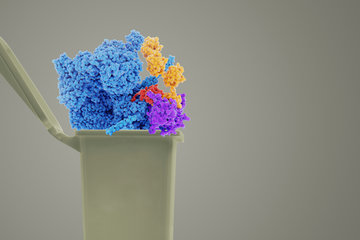Mechanisms governing the function of an ABC transporter
Observation of two conformational states part of the transport cycle of the yeast mitochondrial ABC transporter Atm1
The mitochondrial ABC transporter Atm1 exports an unknown substrate into the cytosol, which is required for the biogenesis of cytosolic iron-sulfur proteins, cellular iron regulation and tRNA thio-modification in yeast. The 3D structures of two complementary states of Atm1 could be determined by electron cryo-microscopy (cryo-EM) attaining resolutions of 2.9 and 3.3 Å, respectively.

The ABC transporter superfamily constitutes one of the largest known protein families, and its members are found in all kingdoms of life. ABC transporters are membrane proteins that contain an ATP-binding cassette (ABC) as a common structural element and are involved in active transport processes across cellular membranes. The energy for substrate transport is provided by ATP (adenosine triphosphate) hydrolysis at the nucleotide-binding domains (NBDs) that form the ABCs.
A team of scientists from the Philips University Marburg and Max Planck Institute of Biophysics in Frankfurt am Main have investigated an ABC transporter of yeast in more detail. The cryo-EM structures characterize the ABC transporter Atm1 in a nanodisc environment that mimics the native lipid bilayer. "We found that the inward-open structure closely resembles the crystal structure of nucleotide-free apo-Atm1. The occluded conformation with the bound ATP analogue AMP-PNP showed close association of the two NBDs, a rearrangement of the C-terminal helices, and closure of the putative substrate-binding cavity in the homodimeric transporter. We were able to identify a hydrophobic region on the C-terminal helices that is unique among type IV ABC transporters with known structure" said Thomas Ellinghaus of the Max Planck Institute of Biophysics.
Thereby, new insights into the stabilization of the yeast Atm1 dimer through its C-terminal helices and into their relative movement during the transport cycle are demonstrated. The identified interactions of the C-terminal helices are conformation-specific. Truncation mutants of yeast Atm1 further indicate that the C-terminal helices stabilize the dimer but are not required for closure of the NBDs, which complements previous in vivo data of Roland Lill’s group in Marburg.
ABC transporters have gained considerable medical, industrial and economic importance as they play a major role, e. g., in multidrug resistance of pathogenic bacteria and in the pharmacokinetics of cancer therapeutics. In addition, gene mutations leading to the expression of non-functional ABC transporters are the causes of various metabolic diseases. A known hereditary disorder resulting from defects to ABCB7, the human orthologue of yeast Atm1, is the iron storage disease XLSA/A (X-linked sideroblastic anemia and cerebellar ataxia). Further examples include cystic fibrosis and adrenoleukodystrophy. Therefore, a functional and structural elucidation of these proteins is in every respect an important basis for the development of appropriate drugs.












